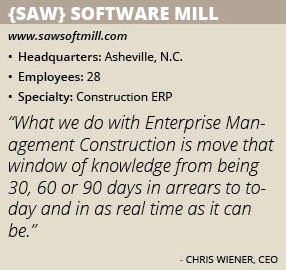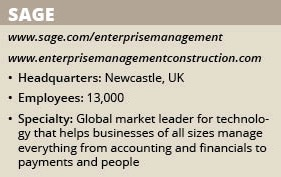Sage Business Cloud Enterprise Management: Revolutionizing Construction Management
Sage introduces features to provide greater construction insight.
In a rapidly changing technology landscape Sage Business Cloud Enterprise Management has evolved to meet the needs of the more than 5,500 organizations globally. “The Enterprise Management solution has been around now for a few years, but as technology moves, it’s our obligation to keep up with that,” says Chris Wiener, CEO of {SAW} Software Mill.
In 2015, {SAW} Software Mill partnered with Sage to develop Sage Business Cloud Enterprise Management Construction. Today, the solution empowers project managers and other stakeholders around the world to better manage the entire construction lifecycle. It captures more granular, work-in-progress project and financial data using one integrated system.
EM Construction is a cohesive module that is available as part of the feature-rich and functional modern business solution that address the complexity and risks faced by today’s mid-tier to larger construction firms.
Faster and More Intuitive
Sage Business Cloud Enterprise Management provides faster, more intuitive and tailored business management solutions than conventional ERP for organizations looking to retain their competitive advantage by increasing their agility and embracing change.
Enterprise Management Construction delivers a data-driven, unified experience built on the proven Enterprise Management platform. Today, the industry solution offers core capabilities for complete construction lifecycle management including: project management, contract and subcontract management, project financial and cash flow management, project document management, timesheet support and project visualization and analytics.
Additionally, Enterprise Management Construction integrates with other Sage solutions, including HR and CRM products. It also integrates with other third-party applications such as Oracle Primavera and Microsoft Project. “This is a fully integrated solution from the Sage ecosystem,” Wiener says. “Enterprise Management Construction gives its customers a unique experience. It works right out of the box and does what it says it does.”
A Program of Continuous Development
Version 12 of the Enterprise Management solution delivers a new user experience that streamlines workflows and accelerates the management of your business. The responsive design automatically adapts to the size of the screen giving users the freedom to work on the best device for the task at hand whether it is a desktop, tablet or mobile. “Enterprise Management understands if I’m working at my desktop, tablet or phone,” explains Robert Sinfield, vice president of product, enterprise management suite for Sage. “It adapts automatically to the size of my screen, making the best use of the available space, and giving me the flexibility I want as a user.”
In addition, this latest version of Enterprise Management delivers significant benefits for distribution, including stock availability, supply chain management, EDI, back-to-back orders and enhanced inventory management with the introduction of License Plate Numbering (LPN). LPN allows for grouping and managing inventory by container.
“You can now drive efficiency across your supply chain, managing logistics and tracking key information for a group of items with a single number, as well as the ability to group and manage inventory you can connect that to distribution to know what goods are on the truck,” Sinfield explains. “If you trust the supply chain and the truck is sealed, you can use the LPN to receive goods into the warehouse and you don’t have to unpack everything. That’s huge in cost savings and performance.”
Enterprise Management Construction was developed for the whole construction industry, including not only those in the field, but also material supply companies, specialty subcontractors such as MEPs, ready mix, roofing, framing and others, and those in the back office overseeing procurement, inventory control and distribution management. “Importantly, the same tool can be used people in the back office and those in the field in low bandwidth environments,” Wiener says. “They all need to access that same set of data in real-time. What we do with Enterprise Management Construction is move that window of knowledge from being 30, 60 or 90 days in arrears to today and in as real-time as it can be. There’s no latency in the system; it comes down to humans putting data into the tool.”
Updates to the solution were made to include a project management module that understood project flow and a cash flow analysis module. Enterprise Management Construction also understands contractual relationships and is flexible enough to accommodate them.
Optimizing Performance
Enterprise Management Construction allows companies to use bill of quantities and bill of materials from a procurement perspective and order things when needed. “Construction has small laydown yards and don’t have a warehouse for materials to build a 50-story tower, for example,” Wiener says. “They typically have one floor, and everything has to go through that up the tower. We have swiftly improved the way BOQ on the construction side is handled.”
The platform uses that information and attaches material labor and the type of labor, so now the material is inputted as an assembly. “When we talk about assembly, it’s converting material into tasks,” Wiener explains. “It’s not just the fire alarm on the wall, for example. Now it’s the alarm on the wall with the conduit, fittings, cable, labor and testing, which allows for things to be tracked at a human level and more understood. It streamlines field reporting.”
Enterprise Management Construction introduced crew reports in the Jobs module last year, allowing reporting from the field on a tablet to document hours, material, rates, equipment run time, expenses and all the things involved on a job site to collect multiple crew reports into a daily or periodic report. “Reports are produced by supervisors to connect them together into a daily job site report, which will include site conditions, weather, safety incidents and any other observations,” Wiener says. “They then take those daily or periodic reports and convert them into job progress reports. Every level is signing off that the team did the work and that’s how to track progress against the job for billable conversion.”
Wiener says the new tool is “incredibly powerful. The job progress report can convert from raw material down to the contractual item,” he says. “A fully installed fire alarm may have a different bill rate than the cost of the materials, and the people in the back office don’t have to understand the field. It smooths out that process and is more flexible.”
Enterprise Management Construction can also provide greater insight into the management of labor by creating staff profiles that include certifications, trade classifications and trade rates. “If Bob is a master welder and he costs the business $40 an hour, but we had to use him because we didn’t have enough journeyman, that’s all tracked in the system and creates a multi-level actual, meaning the actual cost as per the contract versus the actual cost to the business,” Wiener explains. “We can look for real overages at the minute level of detail, so project managers can determine if they want to use Bob, a master welder at a journeyman rate, or delay the work one more day until they are fully staffed.”
The platform allows businesses to more easily make those critical decisions when project managers are informed of the cost implications of those decisions. “That’s really powerful and Enterprise Management Construction lets you do that for a team of four guys doing a restoration project up to a 1,000-person construction team building a new power plant,” Wiener notes. “Being able to understand cost implications and tally them in near real-time is a very powerful addition to the solution.”
Cost-Effective Solution
In January, a major oil and gas specialty contractor in Saudi Arabia purchased Sage Business Cloud Enterprise Management ERP with Enterprise Management Construction. “The oil and gas industry is semi government owned, which mandated the use of an electronic reporting tool rather than Excel spreadsheets to ensure accuracy of the data,” Wiener explains. “They looked at Oracle and SAP at $2.5 million cost of entry with a maintenance cost of $500,000 annually, and then looked at Sage’s Business Cloud Enterprise Management solution that is flexible, adaptive and field-ready at the cost of maintenance at point of entry.”
“As a component of Enterprise Management, Enterprise Management Construction enables construction companies to adapt and helps smaller construction companies stay successful,” Wiener explains. “We have a boat builder customer in the United States that builds massive ferries carrying cars and people. They had pain points around inventory working with specialty material that has to be manufactured specifically for the job. Just being able to manage inventory and attach it down to a certain project has had a significant positive impact already for their business.”
Wiener notes, “EMC enables companies and larger construction companies to adapt and helps smaller companies stay successful. We have a boat builder customer in the United States that builds massive ferries carrying cars and people. They had pain points around inventory working with specialty material that has to be manufactured specifically for the job. Just being able to manage inventory and attach it down to a certain project has had a significant positive impact already for their business.”
What Construction Resellers Can Bring to Customers
Ledgerwood Associates Inc. (LAI) in North America is a certified partner of Enterprise Management Construction. The company has the knowledge and industry experience, having been in the construction industry for more than 40 years. As construction technology has grown over the decades, so has the complexity of projects and financial strategy. LAI recognized it needed to offer solutions according to the project scopes, as well as scalable to the business needs.
“Throughout the years, LAI has had direct exposure to the ever-evolving and changing needs of construction companies, primarily regarding technology and visibility across clients’ organizations,” LAI co-owner Tony Merry says. “While Sage has many industry-leading solutions across major market sectors, a gap existed within the Enterprise level construction vertical, which requires robust and sophisticated processes dedicated to planning and executing large-scale and highly complex projects.”
LAI is uniquely positioned to offer their enterprise-scale clients a more modern, higher performance construction solution that was conceived to perform to global standards. With the principals’ previous experience working in structural steel, high voltage, hydroelectric and utility-scale solar verticals, LAI has the ability to translate complex and lengthy construction phases into operable and profitable executions.
Being on time and on budget truly scales exponentially with enterprise construction, and Sage Enterprise Management is the centralized, scalable solution of choice for LAI.
Enterprise Management Construction brings tomorrow’s best practices to a wide variety of construction, implementation, and project management companies today. In future articles, we will explore more of the key pain points which Enterprise Management and its construction add-in bring to bear on the industry. We will also include more information about {SAW} Software Mill’s and Sage’s global partners and we will get to meet some of the customers implementing the Enterprise Management Construction solution.